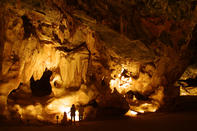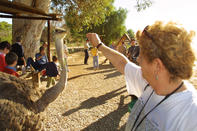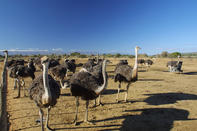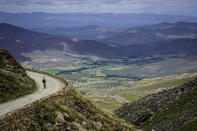Picturesque Cango Valley
The Destination: The rugged and picturesque Cango Valley, in the lee of the legendary Swartberg Mountains, hides the access to one of Africa’s grandest cave systems.

Discover the spectacular subterranean wonder world of the Cango Caves, undoubtedly one of the jewels within the tourism crown of the Klein Karoo. Set within a limestone ridge running parallel to the Swartberg range, this is one of the finest examples of a dripstone cavern you will ever see. The caves were formed over millions of years by rain water seeping through fissures in the limestone. The water gradually dissolved the limestone, forming an extensive network of subterranean caverns and tunnels. When the acidic oxygen in the rainwater comes into contact with the calcium carbonate in the limestone, a crystalline solution is formed, which hardens and eventually accumulates as stalagmites, stalactites and flowstones.
The Experience: The Adventure Tour follows the same basic route as the Standard Tour, through vast halls and past towering formations, but then continues deeper into the cave. From the Devil’s Kitchen you will access the infamous Devil’s Chimney, a steep shaft 45 cm wide leading upwards for some 3,5 metres.
The next challenge is the Devil’s Post Box, and this is only 27 cm high. From the entrance, a flight of stairs descends to Van Zyl’s Hall, an enormous cavern that is 107 meters long, 54 meters at its widest and up to 17 meters in height. Other well-known formations include the 10-meter-high Cleopatra’s Needle - with an estimated age of 150 000 years - the Organ Pipes, the Ballerina and the Frozen Waterfall.
The Detail: Tours depart daily, every hour on the half hour, and lasting 90 minutes. Not suitable for anyone suffering from claustrophobia, back ailments, high blood pressure, or pregnant women.
Cango Wildlife Ranch

Originally established as the first crocodile show farm in South Africa, the Cango Wildlife Ranch is also famous as a breeding centre for cheetah. Visitors on South African holidays can view lion, cheetah, leopard and jaguar from the Catwalk, an elevated walkway that leads through enclosures resembling the animals' natural habitats.
The reptile park has a variety of local and exotic snakes, while the crocodile breeding centre has over 400 crocodile and a large population of American alligator. Regular guided tours are conducted to give visitors a better understanding of these much-maligned reptiles.
Among the unusual animals here are emu (the Australian relative to the ostrich), capybara (the largest rodent in the world), pygmy hippo, wild dog and racoon. Visitors can take a trip around the ranch aboard a mini-train, and there is a mini-farmyard and play park for children.
Home to the World's Largest Ostrich Population

Oudtshoorn used to be a dorp, way back in the day, but has grown into the bustling capital of the Klein Karoo during the past few decades. Its latter-day tourism boom in many ways built upon a solid foundation established its two ostrich booms (1875-1880 and 1899-1902), shaping a multi-faceted city full of big-hearted and friendly folk.
The region offers an extensive list of sights and activities, and an amble through the city streets takes you past a number of imposing period-architecture buildings. The Dutch Reformed church (1839) was the first large, permanent structure built in the Klein Karoo, while a number of ‘Ostrich Palaces’ grace the wide, tree-lined streets.
Oudtshoorn spreads along the twin banks of the Grobbelaars River, and is a perfect halfway stop-over between Cape Town and Port Elizabeth. With ostrich farms, the famous Cango Caves, Klein Karoo Nasionale Kunstefees (KKNK) Festival and a myriad outdoor adventures, chances are you will stay for more than just a night. Oudtshoorn is home to the world’s largest ostrich population.
Cemetery Mountain Bike Route

This return route starts in an old unfenced cemetery (S33°35'09.5"/E22°12'46.4") with trails basically heading upwards in pretty much every direction. Watch out for glass, building rubble, stray belongings and cacti along most of the single-tracks, or alternatively use the rocky road to the top of the hill.
Follow the corridor past the prison fence, consistently heading left till you reach a farm fence, then continue right. Stay close to the wire to your left along the top of a hill with magnificent views of the three surrounding mountain ranges
By Jacques Marais Accommodation in Oudtshoorn consists of quaint guesthouses, charming bed & breakfasts and beautiful lodges with splendid views of the area's...
Accommodation in Oudtshoorn consists of quaint guesthouses, charming bed & breakfasts and beautiful lodges with splendid views of the area's...